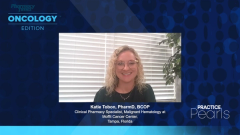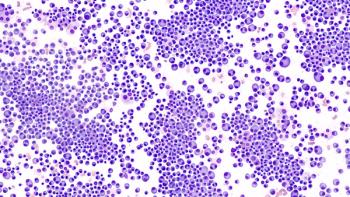
Emerging Therapies for the Management of CLL
Lisa Nodzon, PhD, ARNP, AOCNP, and Javier Pinilla-Ibarz, MD, PhD, evaluate novel agents and combinations in the pipeline for the management of CLL.
Episodes in this series

Javier Pinilla-Ibarz, MD, PhD: Let’s review the new things coming up. We’re going to discuss many of them. I’m going to start with zanubrutinib, another second-generation BTK [Bruton tyrosine kinase] inhibitor, which has a very interesting adverse-effect profile based on the data. Lisa, do you have any comments regarding this phase 3 ALPINE trial in refractory patients?
Lisa Nodzon, PhD, ARNP, AOCNP: When it comes to the BTK inhibitors, what’s nice in the field—with ibrutinib, then acalabrutinib, and now zanubrutinib on the horizon—is that we have multiple options for our patients. It comes down to decision-making, looking at similar efficacy and adverse-effect profiles. As we were talking about earlier, when it comes to decision-making for patients, BTK inhibitors in general have a class effect. The ones that excite us the most are the cardiac ones and the ones for bleeding because the patient population we’re seeing comes into the disease with comorbid conditions, particularly hypertension or a history of cardiac arrhythmias. They may already be on an anticoagulant or an antiplatelet drug, and now the BTK inhibitors come in. We have these BTK inhibitors once or twice a day.
The ALPINE trial showed that zanubrutinib is also tolerated in patients, although we may see more hypertension. We have another drug on the market for patients to select from. A nurse practitioner sees patients and manages toxicities, and a lot of my job is in the support of the patient and those adverse events. The safety data that came out of the ALPINE trial was for a drug that’s well tolerated in the patient population. With these BTK inhibitors, their efficacy comes from the patient maintaining themselves on the drug. For the patients to be maintained on the drug, they have to tolerate the drug. The safety data that came out of the ALPINE trial looked pretty good in terms of tolerability.
Javier Pinilla-Ibarz, MD, PhD: You’re completely right. There were low rates of A-Fib [atrial fibrillation] seen in the trial compared with ibrutinib. You can’t cross-compare with a trial, but you can look at acalabrutinib in ELEVATE. But the population of patients is completely different. It is not as heavily pretreated and obviously is less risk population, and this may play a role on these data. It’s a relatively short follow-up. It’s still unclear with hypertension and neutropenia, but…we can still see the signal with the bruising, hematomas, and sometimes the bleeding, and other things can be seen with BTK.
NCCN [National Comprehensive Cancer Network] recognizes zanubrutinib in situations where other BTK inhibitors can’t be given because of adverse effects. It’s very likely that we’re going to have this drug approved. As you know, it’s approved for mantle cell lymphoma, Waldenström macroglobulinemia, and marginal zone leukemia. The data were presented and a press release reported from the SEQUOIA trial, a very large trial with multiple arms that was presented at ASH [American Society of Hematology Annual Meeting]. This compared zanubrutinib with BR [bendamustine, rituximab] as the classical Alliance for Clinical Trials in Oncology trial. It seems like the adverse-effect profile was quite good.
There also was a presentation in another arm, in the high-risk population, combining zanubrutinib with venetoclax in high-risk patients, including those with 17p. It’s an early readout. We still need to have further follow-up, but they’re striking data, as we’ve seen with other BTK inhibitors in this high-risk population. There are more BTKs in the pipeline. Pirtobrutinib is a different kind of BTK inhibitor. It’s reversible. We’re dealing with irreversible, or covalent, inhibitors, like the ones we’ve discussed: ibrutinib, acalabrutinib, and zanubrutinib. However, the noncovalent, or reversible, inhibitors are coming down the pike. Pirtobrutinib was presented in the BRUIN study, a phase 1/2 study of a very heavily pretreated population of patients with more than 4 or 5 lines of therapy, many of them double refractory. Double refractory means refractory to BTK inhibitors as well as the BCL2 inhibitor venetoclax…. With the follow-up that we’ve already seen, there’s very good durability of a drug that’s coming up. It’s going to face many other BTKs in the market, but it’s very exciting to see these new BTK inhibitors coming up.
Another important thing is combination therapy, which was a big theme at ASH. The main one was the CAPTIVATE trial, which combined ibrutinib with venetoclax. We’ve seen the fixed-duration therapy many times. CLL14 has already been described in 4 to 5 years of follow-up. We’ve seen that the fixed duration is 1 year of this treatment. Obinutuzumab-venetoclax is feasible for patients, but we see that 17p patients relapse shortly after, or at least they have a high tendency to relapse.
The use of monoclonal antibodies is tricky because of the COVID-19 pandemic. We have patients undergoing treatment with CD20 who don’t have any immune response. This is something that may have a weight when we discuss therapy. The recently approved long-term prophylactic antibody against COVID-19 may last 6 or 7 months. It may be a very important tool when using monoclonal antibodies.
There are some other combinations with BTK. BCL2 is obviously the main 1, but there’s also zanubrutinib and venetoclax. We have already good data on ibrutinib-venetoclax from CAPTIVATE, which was presented in 2 different arms: the fixed duration and the MRD [minimal residual disease] driven. It was a very complex trial that randomized patients after treatment with 15 months of ibrutinib-venetoclax, depending on whether it was detectable or undetectable minimal residual disease. In the undetectable 1, it was randomized to observation vs ibrutinib; in the detectable, between ibrutinib and ibrutinib-venetoclax.
What’s the summary of these data after 2 years of follow-up? Everyone is doing fantastic. There’s more than 95% PFS [progression-free survival]. There are very few relapses in each group. It’s unclear how long it’s going to relapse, because it seems possible to incorporate BTK fixed-duration therapy, in this case by combining with venetoclax. Interestingly, MRD is very high this group of patients. CAPTIVATE had younger patients with a high risk of genomic abnormalities. We definitely see better data…in mutated IgA vs unmutated.
Something interesting also seen in venetoclax is that it’s very likely going to bring the approval of combination ibrutinib-venetoclax in the next year, and was combined obviously or was compared with chlorambucil-obinutuzumab. This trial was reported in the summer and at ASH in terms of MRD, which was slightly inferior because this population of patients was older. Some of these patients may not tolerate this combination well, depending on their fitness and their issues. Nevertheless, it’s very interesting.
One other interesting thing that came out the CAPTIVATE study is that the people start to do very well and become somewhat independent of their MRD. The story of the MRD and PFS…is going to be challenged by incorporating BTK into this combination. Patients are doing very well and have deep molecular responses. Lisa, do you have any other comments on the trials I discussed? What do you think is going to fit into our practice in the near future?
Lisa Nodzon, PhD, ARNP, AOCNP: Most of our patients come in recognizing that there’s an option, particularly for patients on BTK inhibitors. They always ask the question, “How can I get off this drug?” Some of our patients with CLL are savvy, recognizing that venetoclax is out and about. What’s exciting is that the regimen itself, ibrutinib and venetoclax, is pretty tolerable in that patient population. Of course, each drug is going to impart its own class effect. There’s the BTK class effect, and now we know that with BCL2 inhibitors neutropenia is of concern. That’s something to bear in mind when we’re treating our patients with 2 different classes of drugs, to be cognizant of the adverse events that can come with both drugs. It was nice that both drugs were well tolerated with very low rates of TLS [tumor lysis syndrome] as well after the ibrutinib lead-in. That’s very important, but offering the time-limited therapy for patients also gives them the freedom of the chronicity of the adverse effects as well as the financial toxicities.
Javier Pinilla-Ibarz, MD, PhD: You bring up a good point because our patients are asking about fixed-duration therapy with BTK, but that’s not on the label right now. There are recently reported data for some patients on ibrutinib…. Another aspect that was surprising was that patients on ibrutinib for more than 2 years were given a regimen that we have a lot of experience with in our institution [Moffitt Cancer Center], the umbralisib-ublituximab combination. A striking amount of patients went to MRD negative, and they were able to discontinue and be off therapy with short follow-ups. These bring the possibility in the future of not only venetoclax but other combination regimens. Someone can even argue that CD20 could be another strategy to get some of our patients to discontinue therapy. Something important for our patients, as you mentioned, is financial toxicity and, more importantly, the chronic adverse events that some suffer may improve the quality of life and put them in a better situation.
Transcript Edited for Clarity
Newsletter
Stay informed on drug updates, treatment guidelines, and pharmacy practice trends—subscribe to Pharmacy Times for weekly clinical insights.





















































































































































































































